Introduction
In today’s digital world, Application Programming Interfaces (APIs) are crucial for software to communicate smoothly. With more and more RESTful APIs being used, it’s vital for testers to ensure they work reliably.
Rest Assured, a Java library simplifies this process. It offers a specific language for writing clear and thorough tests. Rest Assured helps Java developers create strong test suites for checking API functionality, performance, and security. Its easy syntax speeds up testing, ensuring high-quality software.
In this blog post, we’ll explore the significance of Rest Assured, explaining why it’s essential for both developers and testers. Additionally, we’ll offer a detailed guide on setting up a Maven project and provide a practical overview of its primary endpoints like GET and POST requests.
What is Rest Assured?
- Rest Assured is a powerful Java library designed specifically for automating RESTful API testing. It offers a concise and intuitive syntax that allows testers to interact with APIs, send requests, validate responses, and perform various assertions effortlessly. Rest Assured abstracts away the complexities of HTTP protocol handling, making API testing more manageable and efficient.
- REST Assured adopts a BDD format using given, when, and then statements:
- given() – Input details are provided here, including Base URI, Headers, Path Parameters, Query Parameters, and Request Body/Payload.
- when() – Resource and HTTP Request method (POST, GET, PUT, PATCH, or DELETE) are specified.
- then() – The response is validated, encompassing response code, response time, response message, response headers, response body, etc.
Assets of Rest Assured
- Ease of Use: Rest Assured features straightforward syntax, facilitating the creation of readable and maintainable API tests with minimal effort.
- Integration with Java Ecosystem: As a Java-based library, Rest Assured seamlessly integrates with existing Java frameworks and tools, providing convenience for Java developers and testers.
- Rich Assertion Capabilities: Rest Assured offers a wide array of built-in assertion methods. Testers can use these methods to validate various aspects of API responses, including status codes, headers, JSON/XML payloads, and more.
- Support for BDD (Behavior-Driven Development): Rest Assured supports Behavior-Driven Development practices through its expressive syntax. This support encourages collaboration among developers, testers, and stakeholders.
- Extensibility: Rest Assured is highly extensible, allowing users to integrate custom logic, plugins, and third-party libraries to meet specific testing requirements.
Limitations of Rest Assured
- Learning Curve: Rest Assured might be challenging for newcomers due to its Java-based nature and specific API testing concepts.
- Java Dependency: Rest Assured is designed for Java developers, which might not be suitable for teams using different programming languages.
- Limited Non-Java Support: It may not provide robust support for ecosystems outside of Java.
- Setup Overhead: Setting up Rest Assured could involve additional configuration and dependencies, adding complexity to project setup.
- Maintenance: Keeping Rest Assured tests updated with changes in APIs or application codebases may require ongoing effort.
- Performance Impact: Depending on test complexity and suite size, using Rest Assured might introduce performance overhead.
- Lack of GUI: Rest Assured primarily focuses on programmatic test writing, lacking a graphical user interface for non-technical users.
For further insights into Rest Assured, you can check out its official documentation.
Why does Rest Assured outperform Postman in Automating RESTful APIs?
While Postman is a popular tool for manual API testing and collaboration, Rest Assured offers several advantages for automated API testing such as:
- Integration with Development Workflow: Rest Assured seamlessly integrates with Java development environments, allowing testers to incorporate API tests into their automated build and continuous integration pipelines.
- Version Control and Code Reusability: API tests written with Rest Assured can be version-controlled alongside the application code, promoting code reusability and ensuring consistency across different testing environments.
- Programmatic Approach: Rest Assured enables testers to write API tests using Java code, offering more flexibility and control over test execution compared to Postman’s graphical user interface.
- Scalability: Rest Assured scales well for large-scale API testing efforts, thanks to its support for modularization, parameterization, and parallel execution.
Rest Assured these features make it superior to Postman for automating RESTful APIs.
Prerequisite: What is needed before testing APIs with Rest Assured?
Before diving into the details of Rest Assured, it’s crucial to grasp the prerequisites for proficiently employing this tool in API testing.
- Download and Install Java.
- Install IntelliJ IDE.
- Create a Maven Project in IntelliJ.
We’ve already covered the process of downloading and installing the Java Development Kit (JDK) and IntelliJ IDE, as well as setting up a Maven project, In our previous blog on Java with Selenium.
Maven Dependencies for API Testing.
Add Dependencies in the Pom.xml file.
After creating a new project, the initial step is to include dependencies such as Rest Assured, TestNG and JSON Simple in the pom.xml file.
You can find the latest versions of these dependencies on the Maven Repository official website.
<?xml version="1.0" encoding="UTF-8"?>
<project xmlns="http://maven.apache.org/POM/4.0.0"
xmlns:xsi="http://www.w3.org/2001/XMLSchema-instance"
xsi:schemaLocation="http://maven.apache.org/POM/4.0.0 http://maven.apache.org/xsd/maven-4.0.0.xsd">
<modelVersion>4.0.0</modelVersion>
<groupId>org.example</groupId>
<artifactId>RestAssure_Demo</artifactId>
<version>1.0-SNAPSHOT</version>
<properties>
<maven.compiler.source>19</maven.compiler.source>
<maven.compiler.target>19</maven.compiler.target>
<project.build.sourceEncoding>UTF-8</project.build.sourceEncoding>
</properties>
<dependencies>
<!-- https://mvnrepository.com/artifact/io.rest-assured/rest-assured -->
<dependency>
<groupId>io.rest-assured</groupId>
<artifactId>rest-assured</artifactId>
<version>5.4.0</version>
<scope>test</scope>
</dependency>
<!-- https://mvnrepository.com/artifact/org.testng/testng -->
<dependency>
<groupId>org.testng</groupId>
<artifactId>testng</artifactId>
<version>7.9.0</version>
<scope>test</scope>
</dependency>
<!-- https://mvnrepository.com/artifact/com.googlecode.json-simple/json-simple -->
<dependency>
<groupId>com.googlecode.json-simple</groupId>
<artifactId>json-simple</artifactId>
<version>1.1.1</version>
</dependency>
</dependencies>
</project>
Test Case Creation
Create Java Class and Write the Test Scripts for API requests
Generate Java Classes for GET & POST request endpoints naming them as “GetApiTest” and “PostApiTest” within the src > test > java > HTTP methods directory.
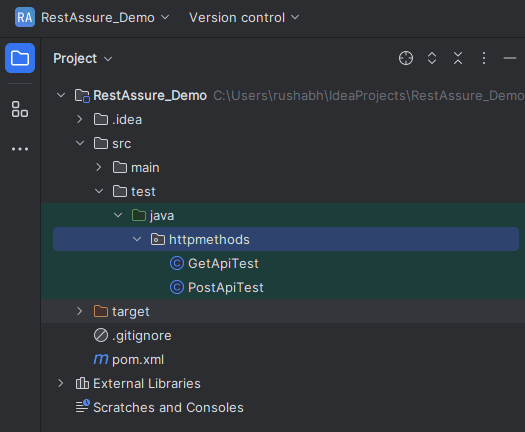
Once the Java classes are created, begin writing a basic test code for GET and POST request endpoints and validating them as described below.
We’ll use a demo website called Reqres to practice testing APIs with Rest Assured. This hands-on approach will help us understand how APIs work by using basic HTTP requests like GET and POST.
GET Request Endpoint
package httpmethods;
import io.restassured.http.ContentType;
import org.testng.annotations.Test;
import static io.restassured.RestAssured.given;
import static org.hamcrest.Matchers.equalTo;
import static org.hamcrest.Matchers.notNullValue;
public class GetApiTest {
@Test
public static void GetApiTest() {
// Performing GET request and validating its response.
given()
// Specifying the Base URI.
.baseUri("https://reqres.in/api")
.contentType(ContentType.JSON)
.when()
//HTTP Request Method.
.get("/users/2")
.then()
// Ensuring that status code is 200 OK.
.statusCode(200)
// Validating Id value.
.body("data.id", equalTo(2))
// Validating Email value.
.body("data.email", equalTo("janet.weaver@reqres.in"))
// Validating First Name value.
.body("data.first_name", equalTo("Janet"))
// Validating Last Name value.
.body("data.last_name", equalTo("Weaver"))
// Ensuring that Avatar value is not null.
.body("data.avatar", notNullValue())
// Log response details
.log().all();
}
}In this, the method is annotated with @Test, indicating that it’s a test method. The method name is GetApiTest.
- given(): This function sets up the initial state for the request. Here, it specifies the base URI for subsequent requests and ensures that the request body is formatted in JSON.
- baseUri: Here, we’ve defined the Base URI for the following request.
- when(): This function represents the HTTP request method, in this case, a GET request.
- then(): This function represents that it verifies the response by making individual assertions such as status code, body content, etc.
Run the Created Test Case
Once the test script is written, proceed to execute the test and carefully analyze the results.
To run the test case, go to the test class or main method or test method click or right-click on it, and choose the “Run” option. The results will be displayed in IntelliJ’s Run tool window.
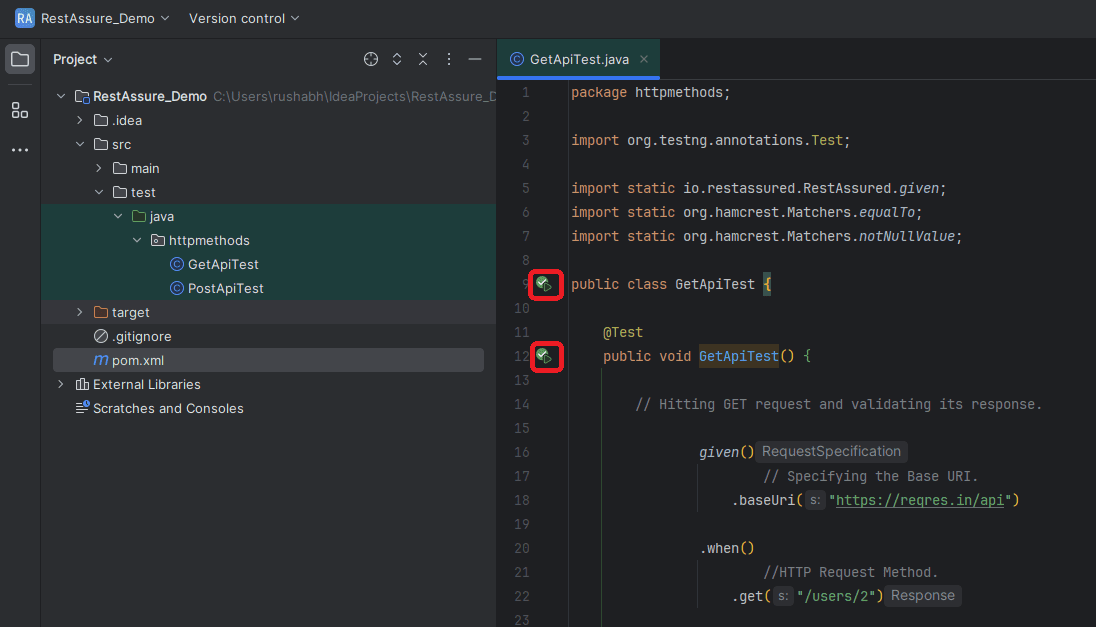
Test Run Results
- The results displayed in IntelliJ’s Run tool window offer vital insights into the test execution.
- The test we formulated has successfully passed, validating its proper functionality as intended.
- Analyzing these outcomes allows us to discern the status of each test – whether they passed, failed, or were skipped.
- This analysis serves to enhance our testing methodologies, refining our scripts to be more accurate and effective.
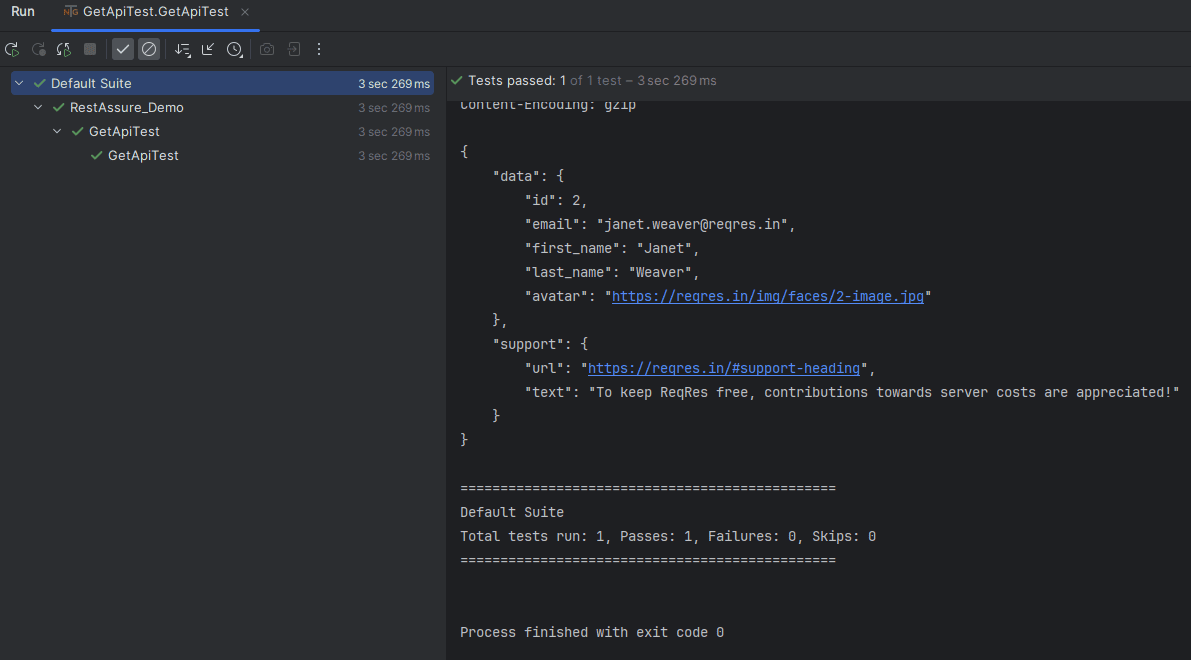
POST Request Endpoint
package httpmethods;
import io.restassured.http.ContentType;
import io.restassured.path.json.JsonPath;
import org.testng.annotations.Test;
import static io.restassured.RestAssured.given;
import static org.hamcrest.Matchers.equalTo;
import static org.hamcrest.Matchers.notNullValue;
public class PostApiTest {
@Test
public static void PostApiTest() {
// Defining the request body.
String requestBody = """
{
"name": "Rushabh Shah",
"job": "QA Automation Engineer"
}
""";
//Converting request body to JSON.
JsonPath expectedResponse = new JsonPath(requestBody);
// Performing POST request and validating its response.
given()
// Specifying the Base URI.
.baseUri("https://reqres.in/api")
.contentType(ContentType.JSON)
.body(requestBody)
.when()
//HTTP Request Method.
.post("/users")
.then()
//Ensuring that status code is 201 OK.
.statusCode(201)
//Validating Name value.
.body("name", equalTo(expectedResponse.getString("name")))
//Validating Job value.
.body("job", equalTo(expectedResponse.getString("job")))
// Ensuring that ID will be generated and returned in response is not null.
.body("id", notNullValue())
// Log response details
.log().all();
}
}
Similar to the approach we discussed earlier for the GET request endpoint, we adhere to the same methodology here as well.
- given(): Just like before, this function prepares everything needed for the HTTP request. But this time, it also includes the data that we want to send along with the request for the POST endpoint.
- baseUri: Sets the base URI for the request.
- body(request body): Attaches the request body defined earlier.
- when(): This method represents the HTTP request method, in this case, a POST request.
- then(): This method similarly confirms the requested response by examining the response body and asserting various aspects such as the status code, body content, etc.
Run the Created Test Case
We follow the same steps as before to execute the test after writing the script and then examine the test results.
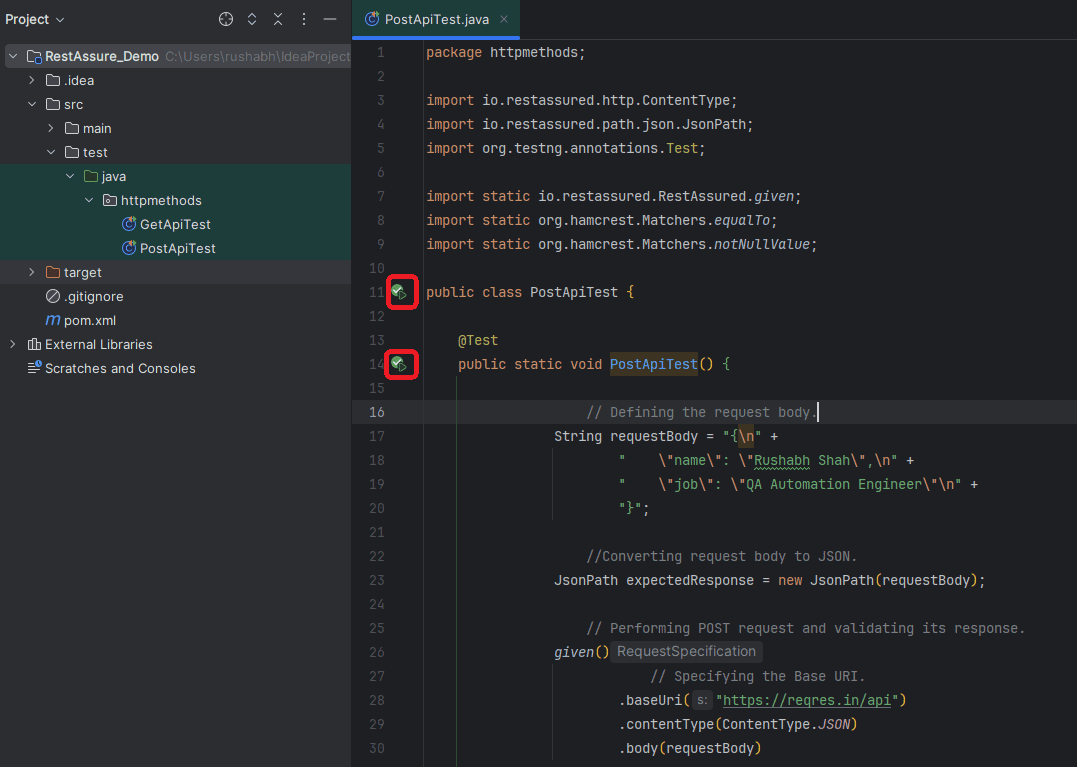
Test Run Results
Below are the test run results shown in IntelliJ’s Run tool window.
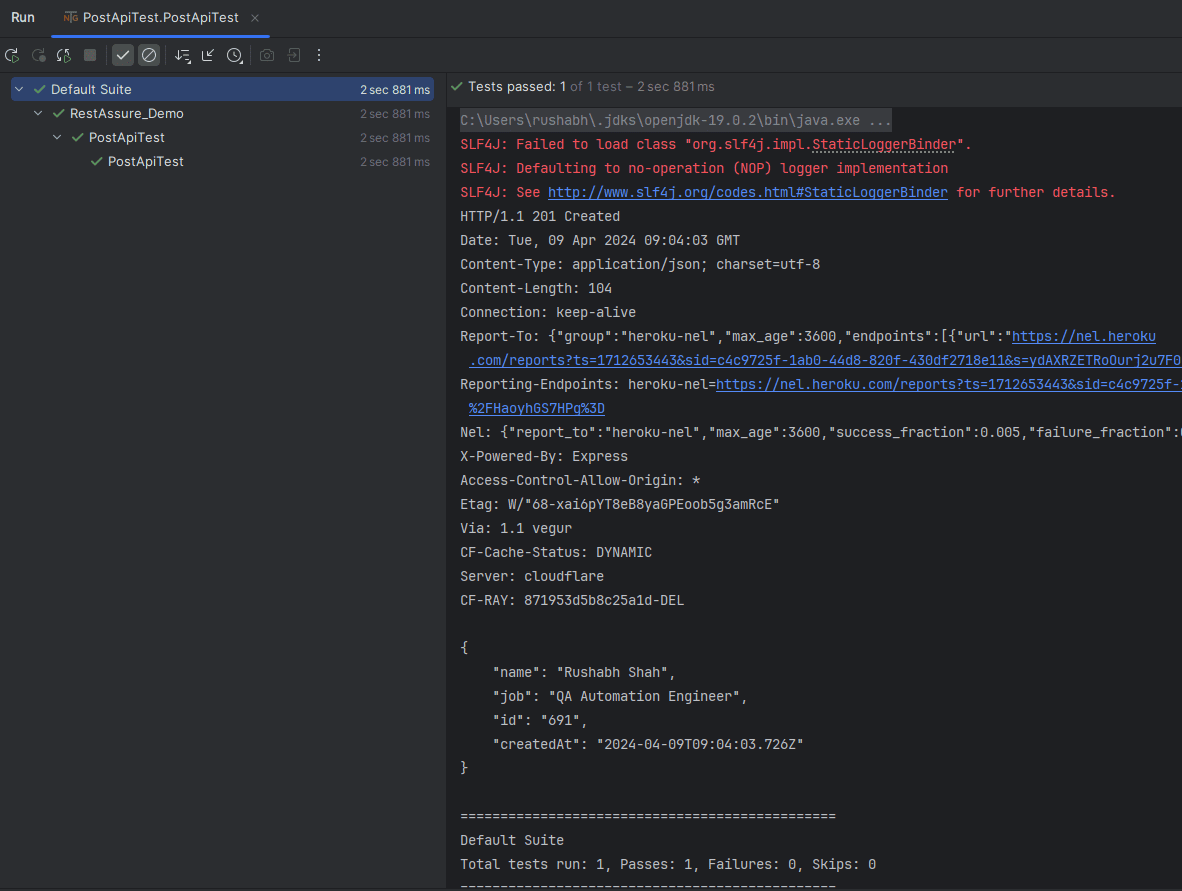
In conclusion, Rest Assured empowers testers to automate API testing effectively by providing a robust framework with intuitive syntax and extensive assertion capabilities. While it may have a learning curve, the benefits of integration with the Java ecosystem, scalability, and programmatic approach outweigh the challenges.
Conclusion
During our journey through API Testing with Rest Assured has provided us with a thorough comprehension of its principles. Through practical examples presented in our blog, we’ve gained hands-on experience and a deep understanding of Rest Assured API concepts, particularly focusing on its primary endpoints.
Keep practicing and exploring to master these powerful tools further with Jignect.
Witness how our meticulous approach and cutting-edge solutions elevated quality and performance to new heights. Begin your journey into the world of software testing excellence. To know more refer to Tools & Technologies & QA Services.
If you would like to learn more about the awesome services we provide, be sure to reach out.
Happy Testing 🙂




